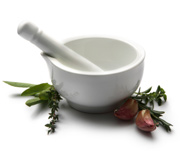
|
My Aching Head We have all suffered a headache at some time or another. Over the last several years, new research has shown that there are basically two types of headaches: mechanical and vascular. Mechanical headaches come about because of joint and muscle dysfunction in the neck. There are seven vertebrae in your neck, making up many different joints. There are also numerous muscles and ligaments in the same area. These anatomical structures are full of nerves that transmit pain into the spinal cord and then up to a part of your brain called the trigeminocervical area. This area of your brain receives pain signals from your neck and the head itself. Thus, whether the source of pain is your head or your neck, your brain doesn't distinguish between the two, and you get a "headache." Chiropractors, as well as other healthcare practitioners, have known for years that when a joint or muscle becomes restricted, it becomes inflamed and sends a message of pain to the brain. Causes of joint restriction can be poor posture, extended use of the computer, stress and lack of exercise. Stress increases muscle tension and restriction of blood flow to the head. According to an article in the Journal of the Neuromusculoskeletal System, the frequency of headaches in both the short and long term was greatly reduced in subjects treated with spinal manipulation — more so than those who received Motrin. There have been over 10 studies in the last 20 years that clearly indicate that spinal manipulation is very effective in relieving headaches. Other studies have shown similar results with massage and acupuncture. Vascular headaches are generally a result of too much vasoconstriction, or narrowing of the arteries, followed by a rapid vasodilation, or widening of the vessels. It is believed that the vasodilation is what actually causes the headache. This imbalance in blood constriction and dilation can be due to food or chemical allergies. There have been numerous studies that clearly identify the relationship of food allergies to headaches. Unfortunately, most allopathic allergists do not recognize food allergies as a major contributor to headaches. Part of the problem is that if an allergenic food is consumed, the proteins from the food circulate throughout the body and gut and signal to the immune system to release white blood cells to react to the food. This is a very slow process and can take hours. On the other hand, some allergens, such as animal hair, molds or even bee stings, use a part of the immune system that is fast-acting and will employ different white blood cells to react to the allergen. Allergists routinely perform skin scratch tests to detect the sort of allergy that has a rapid rather than delayed response. Tests that can detect food allergies:
If you are looking for ways to help get rid of your headaches, and you suspect food allergies, try taking quercetin, 500 mg a day. Evening primrose oil, two grams per day and magnesium, 500 mg a day are also very helpful. Thomas Edison said, "The doctor of the future will give no medicine, but will interest his patients in the care of the human frame, in diet, and in the causes and prevention of disease." This couldn't be truer when it comes to headaches. Allergies and Holistic Healing by Skye Weintraub To learn more about food allergies, go to the "assessments" section of the Great Smokies Diagnostic Lab website.
|
